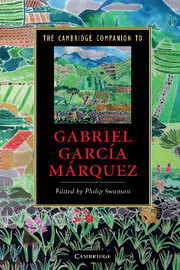Book contents
- Frontmatter
- Introduction
- 1 Gabriel García Márquez: life and times
- 2 The critical reception of García Márquez
- 3 Before One Hundred Years of Solitude: the early novels
- 4 One Hundred Years of Solitude
- 5 An eco-critical reading of One Hundred Years of Solitude
- 6 The Autumn of the Patriarch
- 7 The General in His Labyrinth
- 8 García Márquez’s novels of love
- 9 García Márquez’s short stories
- 10 García Márquez’s non-fiction works
- 11 García Márquez and film
- 12 García Márquez, magical realism and world literature
- Further reading
- Index
10 - García Márquez’s non-fiction works
Published online by Cambridge University Press: 28 September 2010
- Frontmatter
- Introduction
- 1 Gabriel García Márquez: life and times
- 2 The critical reception of García Márquez
- 3 Before One Hundred Years of Solitude: the early novels
- 4 One Hundred Years of Solitude
- 5 An eco-critical reading of One Hundred Years of Solitude
- 6 The Autumn of the Patriarch
- 7 The General in His Labyrinth
- 8 García Márquez’s novels of love
- 9 García Márquez’s short stories
- 10 García Márquez’s non-fiction works
- 11 García Márquez and film
- 12 García Márquez, magical realism and world literature
- Further reading
- Index
Summary
Gabriel García Márquez has been a journalist and fiction writer all his life, and the two genres have intertwined throughout his career. Raymond L. Williams pointedly explains that “journalism has been a constant presence in García Márquez's literary career and personal biography. García Márquez the novelist has gained far more from journalism than just 'contact with reality'. A reading of his journalistic writings during this period, in fact, shows a writer experimenting with a variety of styles, techniques, and genres. Both the enormous volume of García Márquez's journalism and its intimate relationship to his fiction make his journalistic writings essential to a complete study of this work.” / The connection between García Márquez's fiction and his non-fiction is represented by the refrito, or follow-up story, which provides information discovered or events happening after the publication of the original story. The fact that the follow-up story builds upon an already published story often gives it a pejorative connotation and lowly status among journalists. The intersection of his fiction and non-fiction starts during the investigative reporting phase of his work for El Espectador in Bogotá, Colombia in 1954-5. García Márquez wrote three series of follow-up stories in which his writing and narrative technique start to develop.
- Type
- Chapter
- Information
- The Cambridge Companion to Gabriel García Márquez , pp. 144 - 159Publisher: Cambridge University PressPrint publication year: 2010
- 1
- Cited by

